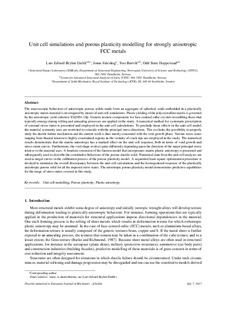| dc.contributor.author | Dæhli, Lars Edvard | |
| dc.contributor.author | Faleskog, Jonas | |
| dc.contributor.author | Børvik, Tore | |
| dc.contributor.author | Hopperstad, Odd Sture | |
| dc.date.accessioned | 2017-10-16T13:43:07Z | |
| dc.date.available | 2017-10-16T13:43:07Z | |
| dc.date.created | 2017-09-13T15:26:03Z | |
| dc.date.issued | 2017 | |
| dc.identifier.citation | European journal of mechanics. A, Solids. 2017, 65 360-383. | nb_NO |
| dc.identifier.issn | 0997-7538 | |
| dc.identifier.uri | http://hdl.handle.net/11250/2460366 | |
| dc.description.abstract | The macroscopic behaviour of anisotropic porous solids made from an aggregate of spherical voids embedded in a plastically anisotropic matrix material is investigated by means of unit cell simulations. Plastic yielding of the polycrystalline matrix is governed by the anisotropic yield criterion Yld2004-18p. Generic texture components for face-centred cubic crystals resembling those that typically emerge during rolling and annealing processes are applied in the study. A numerical method for systematic prescription of external stress states is presented and employed in the unit cell calculations. To preclude shear effects in the unit cell model, the material symmetry axes are restricted to coincide with the principal stress directions. This excludes the possibility to properly study the ductile failure mechanism and the current work is thus mainly concerned with the void growth phase. Various stress states ranging from biaxial tension to highly constrained regions in the vicinity of crack tips are employed in the study. The numerical results demonstrate that the matrix anisotropy has a marked effect on the unit cell response, both in terms of void growth and stress-strain curves. Furthermore, the void shape evolves quite differently depending upon the direction of the major principal stress relative to the material axes. A heuristic extension of the Gurson model that incorporates matrix plastic anisotropy is presented and subsequently used to describe the constitutive behaviour of the porous ductile solid. Numerical data from the unit cell analyses are used as target curves in the calibration process of the porous plasticity model. A sequential least-square optimization procedure is invoked to minimize the overall discrepancy between the unit cell calculations and the homogenized response of the plastically anisotropic porous solid for all the imposed stress states. The anisotropic porous plasticity model demonstrates predictive capabilities for the range of stress states covered in this study. | nb_NO |
| dc.language.iso | eng | nb_NO |
| dc.publisher | Elsevier | nb_NO |
| dc.rights | Attribution-NonCommercial-NoDerivatives 4.0 Internasjonal | * |
| dc.rights.uri | http://creativecommons.org/licenses/by-nc-nd/4.0/deed.no | * |
| dc.title | Unit cell simulations and porous plasticity modelling for strongly anisotropic FCC metals | nb_NO |
| dc.type | Journal article | nb_NO |
| dc.type | Peer reviewed | nb_NO |
| dc.description.version | acceptedVersion | nb_NO |
| dc.source.pagenumber | 360-383 | nb_NO |
| dc.source.volume | 65 | nb_NO |
| dc.source.journal | European journal of mechanics. A, Solids | nb_NO |
| dc.identifier.doi | 10.1016/j.euromechsol.2017.05.004 | |
| dc.identifier.cristin | 1493431 | |
| dc.description.localcode | © 2017. This is the authors’ accepted and refereed manuscript to the article. LOCKED until 28.5.2019 due to copyright restrictions. This manuscript version is made available under the CC-BY-NC-ND 4.0 license http://creativecommons.org/licenses/by-nc-nd/4.0/ | nb_NO |
| cristin.unitcode | 194,64,45,0 | |
| cristin.unitname | Institutt for konstruksjonsteknikk | |
| cristin.ispublished | true | |
| cristin.fulltext | postprint | |
| cristin.qualitycode | 1 | |

